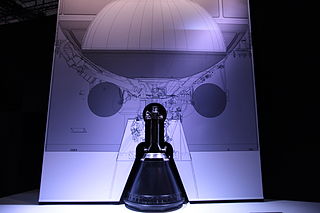
Spacecraft propulsion is any method used to accelerate spacecraft and artificial satellites. In-space propulsion exclusively deals with propulsion systems used in the vacuum of space and should not be confused with space launch or atmospheric entry.

An ion thruster, ion drive, or ion engine is a form of electric propulsion used for spacecraft propulsion. It creates thrust by accelerating ions using electricity.
Specific impulse is a measure of how efficiently a reaction mass engine creates thrust. For engines whose reaction mass is only the fuel they carry, specific impulse is exactly proportional to exhaust gas velocity.

SMART-1 was a Swedish-designed European Space Agency satellite that orbited around the Moon. It was launched on 27 September 2003 at 23:14 UTC from the Guiana Space Centre in Kourou, French Guiana. "SMART-1" stands for Small Missions for Advanced Research in Technology-1. On 3 September 2006, SMART-1 was deliberately crashed into the Moon's surface, ending its mission.

BepiColombo is a joint mission of the European Space Agency (ESA) and the Japan Aerospace Exploration Agency (JAXA) to the planet Mercury. The mission comprises two satellites launched together: the Mercury Planetary Orbiter (MPO) and Mio. The mission will perform a comprehensive study of Mercury, including characterization of its magnetic field, magnetosphere, and both interior and surface structure. It was launched on an Ariane 5 rocket on 20 October 2018 at 01:45 UTC, with an arrival at Mercury planned for on 5 December 2025, after a flyby of Earth, two flybys of Venus, and six flybys of Mercury. The mission was approved in November 2009, after years in proposal and planning as part of the European Space Agency's Horizon 2000+ programme; it is the last mission of the programme to be launched.

SABRE is a concept under development by Reaction Engines Limited for a hypersonic precooled hybrid air-breathing rocket engine. The engine is being designed to achieve single-stage-to-orbit capability, propelling the proposed Skylon spaceplane to low Earth orbit. SABRE is an evolution of Alan Bond's series of LACE-like designs that started in the early/mid-1980s for the HOTOL project.

The German Aerospace Center, abbreviated DLR, is the national center for aerospace, energy and transportation research of Germany. Its headquarters are located in Cologne and it has multiple other locations throughout Germany. The DLR is engaged in a wide range of research and development projects in national and international partnerships. In addition to conducting its own research projects, DLR also acts as the German space agency. As such, it is responsible for planning and implementing the German space programme on behalf of the German federal government. As a project management agency, DLR also coordinates and answers the technical and organisational implementation of projects funded by a number of German federal ministries.

The gas-generator cycle is a power cycle of a bipropellant rocket engine. Some of the propellant is burned in a gas generator and the resulting hot gas is used to power the engine's pumps. The gas is then exhausted. Because something is "thrown away" this type of engine is also known as open cycle.

The gridded ion thruster is a common design for ion thrusters, a highly efficient low-thrust spacecraft propulsion running on electrical power. These designs use high-voltage grid electrodes to accelerate ions with electrostatic forces.

Vulcain is a family of European first stage rocket engines for Ariane 5 and the future Ariane 6. Its development began in 1988 and the first flight was completed in 1996. The updated version of the engine, Vulcain 2, was first successfully flown in 2005. Both members of the family use liquid oxygen/liquid hydrogen cryogenic fuel. The new version under development for Ariane 6 will be called Vulcain 2.1.

A rocket engine test facility is a location where rocket engines may be tested on the ground, under controlled conditions. A ground test program is generally required before the engine is certified for flight. Ground testing is very inexpensive in comparison to the cost of risking an entire mission or the lives of a flight crew.

Vinci is a European Space Agency cryogenic liquid rocket engine currently under development. It is designed to power the new upper stage of Ariane 6.
The Future Launchers Preparatory Programme (FLPP) is a technology development and maturation programme of the European Space Agency (ESA). It develops technologies for the application in future European launch vehicles (launchers) and in upgrades to existing launch vehicles. By this it helps to reduce time, risk and cost of launcher development programmes.
Started in 2004, the programmes initial objective was to develop technologies for the Next Generation Launcher (NGL) to follow Ariane 5. With the inception of the Ariane 6 project, the focus of FLPP was shifted to a general development of new technologies for European launchers.
FLPP develops and matures technologies that are deemed promising for future application but currently do not have a sufficiently high technology readiness level (TRL) to allow a clear assessment of their performance and associated risk. Those technologies typically have an initial TRL of 3 or lower. The objective is to raise the TRL up to about 6, thus creating solutions which are proven under relevant conditions and can be integrated into development programmes with reduced cost and limited risk.
A cold gas thruster is a type of rocket engine which uses the expansion of a pressurized gas to generate thrust. As opposed to traditional rocket engines, a cold gas thruster does not house any combustion and therefore has lower thrust and efficiency compared to conventional monopropellant and bipropellant rocket engines. Cold gas thrusters have been referred to as the "simplest manifestation of a rocket engine" because their design consists only of a fuel tank, a regulating valve, a propelling nozzle, and the little required plumbing. They are the cheapest, simplest, and most reliable propulsion systems available for orbital maintenance, maneuvering and attitude control.

Ariane 6 is a European expendable launch system currently under development by ArianeGroup on behalf of the European Space Agency (ESA). It is intended to replace the Ariane 5, as part of the Ariane launch vehicle family. The stated motivation for Ariane 6 is to halve the cost compared to Ariane 5, and double the capacity for the number of launches per year.
Atmosphere-breathing electric propulsion, or air-breathing electric propulsion, shortly ABEP, is a propulsion technology for spacecraft, which could allow thrust generation in low orbits without the need of on-board propellant, by using residual gases in the atmosphere as propellant. Atmosphere-breathing electric propulsion could make a new class of long-lived, low-orbiting missions feasible.

A liquid apogee engine (LAE), or apogee engine, refers to a type of chemical rocket engine typically used as the main engine in a spacecraft.

Liquid Fly-back Booster (LFBB) was a German Aerospace Center's (DLR's) project concept to develop a liquid rocket booster capable of reusing for Ariane 5 in order to significantly reduce the high cost of space transportation and increase environmental friendliness. LFBB would replace the existing solid rocket boosters, providing main thrust during the liftoff. Once separated, two winged boosters would perform an atmospheric entry, fly back autonomously to the French Guiana, and land horizontally on the airport like an aeroplane.
The S400 is a family of pressure fed liquid propelled rocket engines manufactured by ArianeGroup at the Orbital Propulsion Centre in Lampoldshausen, Germany.
The Orbital Propulsion Centre Lampoldshausen, a Division of ArianeGroup, is the European competence centre for development and production of satellite and orbital propulsion systems. Founded in 1963 by Ludwig Bölkow as a branch of the Bölkow-Entwicklungs-KG, the centre is situated within the German Aerospace Center (DLR) site at Lampoldshausen, Germany.
















